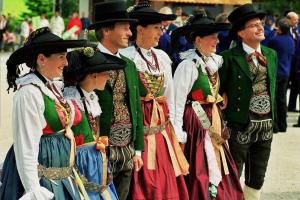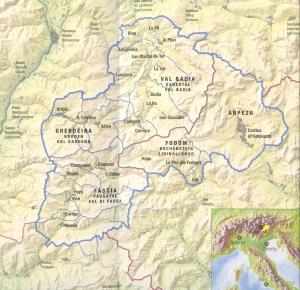Today we are taking a journey back in time, back to more than 2,000 years ago. In those days modern South Tyrol was still in the Bronze Age. There was no such thing as writing, or records, or 'history'. We are talking about pre-historic times.
A story without history?
And yet still today there are accounts of former happenings, encoded and summarised by word of mouth. Individual destinies have blended into archetypes. In those days the focus was on the morals that could be gained from human fate for the benefit of the community rather than the glorification of individual characters. In the last century the meaning of these oral traditions started to be recognised, recorded and sorted out. Attempts were made to fashion a classic story out of these Dolomite sagas.
About the sagas

Traditional Costumes of Gardëina Valley.
Foto: Ladin Culture Institut Micurà de Rü
What can be read into the sagas from a historical perspective? The people were peaceful, matriarchal, with fertile land where piles of rocks may be seen today. The tales bear witness to a life at one with nature until foreign people came looking for land and abolished their customs and traditions. It is said that these people were the Romans, particularly Drusus, when he was stationed in modern-day Bozen in 15 B.C. during his quest to conquer the world. The conquerors named the province after the people living here - Rhaetia.
What historical research has to say
There are lots of rumours surrounding the origins of the Rhaetians, little of which is supported scientifically, and some of which has been gleaned from excavations and names of localities. The tribe is said to be a Celtic or suppressed Etruscan one. The subjugation and suppression of the Rhaetians by the Romans and their mixing with mercenaries and merchants speaking vulgar Latin has been historically documented. A Romance language was born of this situation, which has survived to this day in 3 versions: Rhaeto-Romanic in Switzerland, Ladin in the Dolomite valleys and Friulian in the north Italian province of Friuli.
The route to the present day
In subsequent centuries, as the Roman star was falling and the Roman Empire gave way to the pressure exercised by Germanic people migrating from the north, the Rhaetians and their language was also pushed back into remote valleys. This is how the linguistic and cultural islands that we know today came about.
Children of the Dolomites

The 5 Ladin valleys.
Foto: Ladin Culture Institute Micurà de Rü
One of these islands is Ladinien, which is made up of 5 valleys around the Sella massif. At a political level it is divided into 3 provinces, which is a significant impediment to the people's further development as an ethnic minority. Above all, their recognition as an ethnic minority in their own right differs between the provinces. Therefore, Gardëina (Gröden) and Val Badia (Gader- or Abteital) have the status of the third ethnic group in South Tyrol and the Ladin language is recognised as the official language in the Ladin villages. The Ladin people living in Fascia (Fassa valley) have recognition as an ethnic minority in Trentino, yet they have no rights as such as a group. Fodom (Buchenstein) and Anpezo (Cortina d'Ampezzo), on the other hand, belong to Belluno and are ignored as a Ladin area on the political stage.
What does the future hold?
The
Micurà de Rü Ladin Culture Institute is making efforts to maintain and further develop Ladinien. It organises and promotes initiatives which focus on the Ladin language and culture. It publishes books on the Ladin language and on various subjects concerning Ladin culture, written in Ladin and other languages, too. The library, where all manner of treasures surrounding the Ladin language and culture are kept, will be of great interest to inquisitive visitors.
If you really want to delve into this new, ancient world, we recommend that you
rent a room from a private landlord or landlady. Don't be afraid to ask the locals about Ladinia: you will have interesting conversations and find out lots of surprising things!